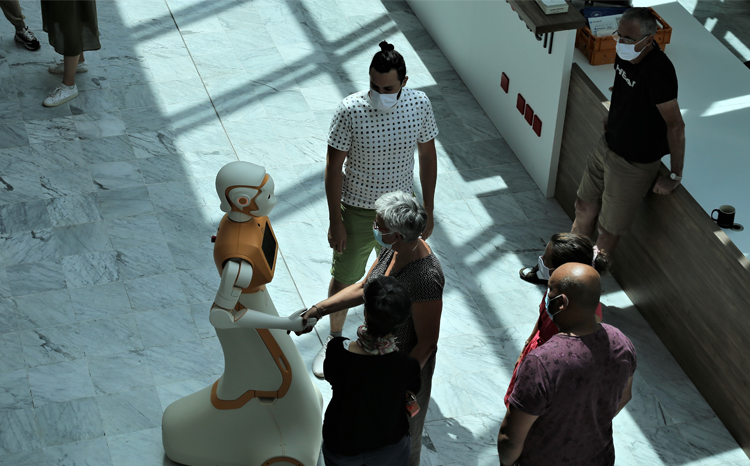How robots can turn the NHS from a cost centre to an economic driver
- 6 November 2024

With the right support, the UK’s world-leading healthcare robotics could ease pressure on the NHS and boost national prosperity, writes Lisa Farrell at the National Robotarium.
As the NHS grapples with unprecedented pressures, from staffing shortages to mounting waiting lists, and with output still 16% below pre-pandemic levels, there’s a transformative opportunity we risk overlooking: robots.
The health secretary has launched the largest consultation on the NHS’s future since its creation in 1948, yet discussions about healthcare modernisation continue to focus on operational efficiency and cost management. Robotics technology offers something far more ambitious – the potential to transform our health service from a cost centre into a powerful driver of economic growth.
NHS England’s expected commissioning budget of £192bn in 2024/25 represents an extraordinary opportunity, with the Autumn Budget confirming record levels of capital investment in health – including £2bn specifically for NHS technology and digital transformation – to lay the foundations for change.
Even a modest 0.1% improvement in efficiency through robotics could generate in excess of £190m in annual savings for reinvestment in innovation. More ambitious adoption could unlock billions – but the real prize isn’t just in cost savings.
It’s in leveraging the NHS’s scale and purchasing power to build a thriving UK robotics industry that creates high-skilled jobs and positions Britain as a global leader in healthcare innovation.
Unique advantages
The global healthcare robotics market is projected to reach £24bn by 2035, and other countries are already moving aggressively to capture this opportunity. China has announced plans to mass-produce humanoid robots by 2025, while South Korea is investing $2.3bn in robotics development by 2030. Yet the UK has unique advantages in this race, as demonstrated by our world-leading innovations across several crucial areas of healthcare robotics.
We’re already seeing promising examples of UK-developed healthcare robotics making an impact. Take Touchlab, which has developed a telerobot equipped with electronic skin technology that allows clinicians to ‘feel’ patients remotely. Launched as part of a recent European hospital pilot, this technology could dramatically reduce healthcare-associated infections, which affect up to 15% of patients in some countries.
Meanwhile, socially assistive robots like those being developed in the UK and tested in healthcare settings in France are showing how automation can support overstretched staff by engaging with patients, answering questions, and improving mental wellbeing in healthcare settings.
Furthermore, British researchers have successfully trialled robotic ‘coaches’ that help stroke and brain injury survivors with their rehabilitation exercises in Austria. By using headsets to detect brain activity, these robots provide real-time motivation and feedback – addressing a crucial need, given that only 31% of stroke survivors currently complete their prescribed rehabilitation routines.
Innovators forced overseas
Yet too often, promising UK innovations struggle to find domestic adoption and end up being commercialised overseas. The NHS’s procurement processes can make it challenging for innovative companies to gain traction, even when their solutions could deliver significant benefits. Without a clear pathway to NHS adoption, many start-ups look to international markets where there’s more appetite for innovation – taking their intellectual property, talent, and economic value with them.
With over 32,000 nursing vacancies in England alone, there’s a clear need for solutions that can support our healthcare workforce. Robotics could take on routine tasks, allowing nurses to focus more on direct patient care and complex decision-making. From automated guided vehicles (AGVs) handling hospital logistics to robotic assistants supporting surgery, these technologies could transform both patient outcomes and staff experiences.
Moreover, by becoming an informed and ambitious customer for robotics technology, the NHS could help create thousands of high-skilled jobs across the UK. We’re not just talking about traditional engineering roles – healthcare robotics creates opportunities for software developers, data scientists, clinical specialists, and many other technical roles. This could open exciting new career pathways within healthcare, helping to attract and retain talent in the sector.
To realise this potential, we need a more coordinated approach. The concept of a National Health Robotarium – a dedicated innovation hub connecting NHS needs directly with UK robotics developers – could accelerate adoption by providing a space for collaborative development and testing, working in concert with the government’s commitment to life sciences as a priority growth sector in its new industrial strategy. This would allow healthcare providers to shape solutions that genuinely meet their needs while giving developers the insights and feedback needed to refine their technologies.
Rethink procurement processes
We also need to rethink procurement processes to better support innovation. Rather than focusing solely on immediate costs, the NHS should consider the broader economic benefits of supporting UK-developed technologies. This could include using mechanisms like advance market commitments to give developers confidence in future demand, making it easier to attract investment and scale their solutions.
The UK now has a window of opportunity with the Autumn Budget committing £13.6bn in NHS capital investment for 2025-26 that could support technological transformation. We have the expertise and innovation capability to compete – but only if we recognise the NHS’s potential as a catalyst for economic growth, not just a consumer of healthcare technology.
Let’s expand our vision beyond just modernising the NHS. By embracing robotics strategically, we can create a healthcare system that’s not only more efficient and effective but also drives innovation and economic prosperity across the UK. The choice – and the opportunity – is ours.





